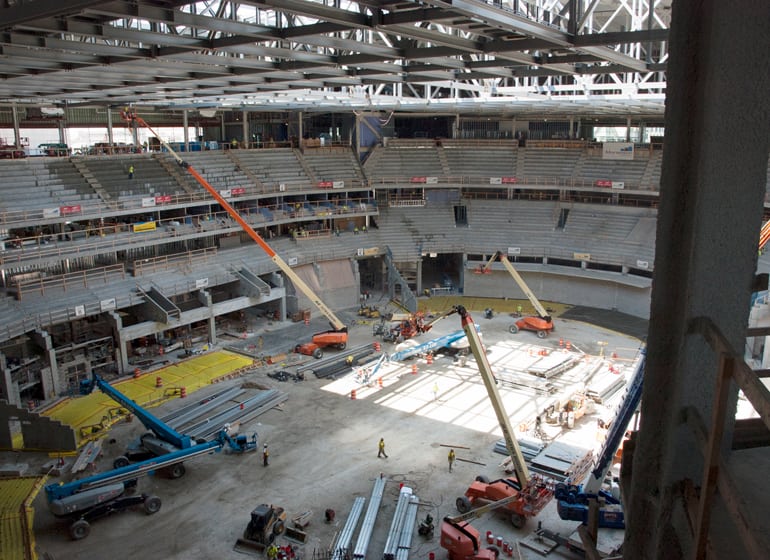Burlington native Mike Sorge has worked on buildings all around the country. Each one is unique, but coming home to work on a new basketball arena in the heart of downtown Milwaukee was a particularly special experience.
Nearly 2 million work hours went into building the Fiserv Forum, the new home of the Milwaukee Bucks. More than 8,000 tons of structural steel, seven trusses spanning 250 to 310 feet, and more than 113 miles of electrical conduit make up the building.

But Sorge, construction executive and project director at arena construction manager M.A. Mortenson Co., hopes fans attending games and concerts at the new arena don’t notice any particular construction and engineering feats that make the building possible. He wants them to walk away with an incredible experience and a desire to return.
“That’s what matters,” Sorge said. “The building itself supports doing that.”
The Bucks awarded the project to Minneapolis-based Mortenson in April 2016, leaving just a few months to prepare for a groundbreaking in June. Sorge said the quick start presented one of the major challenges for the project as the Mortenson team scrambled to get plans in place.
“We were very successful at the point, which set up the overall success of the project,” he said.
In addition to Mortenson, the project also included management by Greenwood Village, Colorado-based Icon Venue Group LLC; architecture by Kansas City-based Populous, Milwaukee-based Eppstein Uhen Architects Inc. and Kansas City-based HNTB; mechanical engineering by Golden, Colorado-based M-E Engineers Inc.; and structural engineering by HNTB and Houston-based Walter P. Moore. Sorge said the team assembled by the Bucks made a significant contribution to the success of the project.
“They’ve really added a lot of value and helped refine the building as we went along,” he said.
The first structural steel was installed in November 2016 and the building was topped off in August 2017. The project was granted conditional occupancy by May 31 this year, allowing the Bucks to begin moving in to the arena. Sorge said each arena and stadium construction project is unique in its own way, but the timeline was about normal for the industry.
“We didn’t run into any big challenges,” Sorge said.
He credited the Bucks organization for helping the project succeed, pointing to outreach events with the business community and town hall meetings that helped recruit workforce for the project in different aldermanic districts.
“When you take it to the community, it’s a lot easier for those community members to come and see what it’s all about,” Sorge said.
At the peak, about 900 workers were on site at one time, and over the course of two years more than 4,000 different workers contributed to the project.
“There were a lot of craft workers that put their heart and soul into this project … They should be very proud of it,” Sorge said.
The project also hit its targets for inclusion, with 33 percent of the work completed by small or disadvantaged businesses – compared to a 25 percent goal – and 43 percent of the work hours performed by Residents Preference Program-certified workers, compared to a 40 percent goal.
Minority participation of 32 percent outpaced a goal of 8 percent and participation by women of 7 percent was slightly ahead of a 6.7 percent goal, Sorge said.
Ken Kraemer, executive director of Building Advantage, the region’s construction labor management council, said the amount of attention given to the arena made it a tool in recruiting new workers to the construction industry.
“The Bucks are such a high-profile project,” he said. “It really complemented and highlighted the opportunity in the skilled trades.”
Kraemer added the arena project also helped solidify the small business and RPP programs as a way of doing business following their use on the Northwestern Mutual Tower and Commons project.
“That’s the model. That should be the model for Milwaukee,” he said. “If I want the community to be part of my business model, I have to be part of the community.”
Businesses have shifted away from looking at the programs as an added cost and are instead trying to leverage them with the understanding that there is a wider benefit.
“We’re seeing these contractors that are doing their presentations and they’re including it as part of their business model,” Kraemer said.
He said projects like the arena and Northwestern Mutual have helped change the views of schools and guidance counselors when it comes to construction careers.
If the plans for Milwaukee’s NBA team come together as well as the arena, there is a chance the Fiserv Forum could turn into a distinct home court advantage. Sorge said he got a taste of that when the arena’s audio and lighting system were being tested.
“(Even) without the fans in there, you could feel it was electric,” he said.

